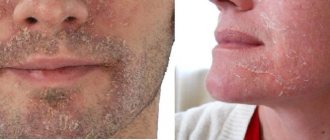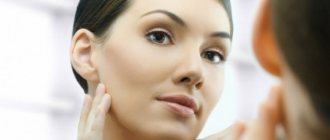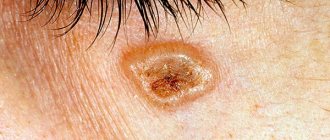Many people experience flaky skin under their eyes from time to time. Factors leading to a violation of her condition can be for a variety of reasons. Therefore, it is necessary to know exactly their origin.
The most common triggers for this condition are:
- hormonal dysfunctions;
- dysbacteriosis;
- thyroid diseases;
- excessive passion for tanning;
- infection;
- changes in water-salt metabolism;
- lack of sleep;
- poisoning;
- ophthalmological diseases;
- parasitosis, etc.
Fungus
This factor ranks high among the causes of redness and flaking of the skin under the eyes.
As a rule, the doctor in such cases diagnoses “seborrheic dermatitis”. This pathology is due to the fact that the infection spreads from the scalp to the lower sections. The disease progresses quite quickly, so the patient needs immediate medical attention.
People who wear contact lenses on their eyes also need to be especially careful. If storage and care rules are violated, the development of an eye infection, including a fungal one, cannot be ruled out.
In addition, you should choose only high-quality optics that do not allow various types of contaminants to accumulate on the surface. Otherwise it will start to peel off. Such disadvantage quickly leads to a decrease in the body’s defenses, which allows fungal microflora to become more active.
Avitaminosis
Lack of vitamins disrupts the processes of cell division of the skin. It affects the entire condition of the person as a whole and affects the structure of the epidermis. The deficiency of retinol and tocopherol most strongly provokes peeling of the eyelids.
As a rule, it occurs in the spring. In some cases, a decrease in the overall resistance of the skin occurs due to serious illnesses, past infections or an unbalanced diet. Wrong lifestyle also plays a big role.
Allergy
The skin under the eyes often peels due to contact with substances that disrupt the functioning of the immune system and provoke an increased response from it.
These include:
- household chemicals;
- cosmetics;
- medicines;
- Food;
- pollen;
- synthetics, etc.
Sometimes the eyelids peel immediately after interaction with the antigen, and sometimes only after a certain time.
An allergic reaction can affect the mucous membranes of the eyes and facial skin. It causes peeling, itching, redness and swelling of the eyelids.
Demodex eyelash mite
Sometimes the patient suffers as a result of parasite infestation. One of the main causes is demodicosis.
The pathology can be hidden for some time, and then manifest itself with the most striking symptoms. In such a case, a person complains of redness of the eyelids, itching, peeling of scales, swelling and general dryness of the skin under the eyes. In advanced cases, eyelash loss and the formation of ulcers are noted.
Typically, making a diagnosis takes some time and requires the use of laboratory research methods.
Improper care
In women, peeling under the eyes often develops due to insufficient care of this area of the face, which is particularly sensitive.
Makeup left on overnight has a particularly adverse effect on the skin. Excessive finger movements when applying cream under the eyes or intense massage of the eyelids can also cause irritation.
Very often, peeling can be caused by incorrectly selected care products. The use of foundations for oily skin with a dry skin type leads to even greater drying of the tissues.
Other factors could be:
- inappropriate eye masks;
- careless removal of mascara and shadows;
- an abundance of water procedures with aggressive detergents;
- use of coarse soap;
- rubbing the skin with various medications not prescribed by a specialist;
- scrubs that are too active;
- tonics, non-moisturizing eyelids, etc.
If you don't take proper care of the skin under your eyes, it may lose its elasticity. Blood circulation processes will be disrupted, turgor will be reduced and color will be changed.
Inappropriate cosmetics
Often the skin peels due to the use of expensive cosmetics that are not suitable for its type. Sometimes, on the contrary, people settle on cheaper options without first studying the composition of the cream or mascara.
In some cases, women buy cosmetics for younger or older skin, which also adversely affects the condition of the epithelium under the eyes.
An unbalanced composition of eye cosmetics leads to clogging of pores, irritation of tissues, and drying out of the epidermis. The skin peels off, allergic reactions and inflammatory processes develop.
Lack of fluid
Often the eyelids peel due to a lack of moisture in the structure of the epidermis. It can have both local and general causes.
A similar phenomenon often occurs if there is a lack of fluid in the body. It begins to evaporate intensively from the outer covers and is not replenished from the inside. Overdrying of tissues, their irritation, and cell death occurs.
The body's water-salt balance must be maintained at the proper level. A person needs to ingest at least 2.5 liters of clean drinking water per day. You should not choose lemonade, beer, alcohol, coffee and factory-made nectars for drinks.
Local causes may be associated with excessively long exposure to the sun or in a hot room. Since the area around the eyes is particularly sensitive and has a very thin layer of epidermis, dehydration affects it the most. Therefore, it is necessary to use moisturizers and drink enough fluids.
Adverse external factors
The skin often peels off under the influence of the surrounding atmosphere. The greatest negative impact on it is exerted by:
- inhalation of tobacco smoke;
- long stay indoors;
- strong wind;
- rain;
- freezing;
- temperature changes;
- various pollution;
- infection from air or water;
- scratching the skin;
- insect bites;
- ecology;
- electromagnetic waves from a computer, etc.
If the office does not provide conditions for employees to smoke, breaks for ventilation are not taken, or the room is too hot, then the skin suffers significantly from such influences.
Walking in the bright sun without special glasses to protect your eyes, spending a long time outside in bad weather conditions, or a long flight can also worsen your skin condition.
Sea swimming combined with excess tanning can cause your eyelids to peel. Chlorinated pool water has a similar effect. Involvement in sports that involve open stadium conditions also often leads to the development of irritation.
Causes and provoking factors
Sensitive eyelid skin reacts negatively to any negative external influence. The epidermis turns red, cracks and peeling appear. Also, such symptoms can signal a malfunction of the internal organs. Most often, problems with the skin around the eyes are caused by the following factors:
- Allergic reaction;
- Use of low quality cosmetics;
- Eyelash mite causing demodicosis;
- Inflammatory lesion of the epidermis resulting from exposure to damaging factors;
- Failure to comply with personal hygiene rules;
- Fatigue of the organ of vision;
- Exposure to sunlight;
- Weathering;
- Spending a long time in front of a computer monitor;
- Lack of vitamins;
- Infectious disease;
- Dry eye syndrome;
- Fungus.
| Several factors can simultaneously cause peeling of the eyelid. To stop the disease, it is necessary to identify them all and eliminate them with the help of well-chosen therapy. |
Allergy
One of the most common reasons causing the development of anomalies. When a person comes into contact with an allergen, the eyes become very watery, and accordingly the skin becomes irritated and begins to peel off. The longer the body is exposed to the “pest”, the stronger the unpleasant symptoms.
Most often, a negative reaction occurs upon contact with the following irritants:
- Plant pollen;
- Animal wool;
- Cosmetical tools;
- Products;
- Dust;
- Harmful fumes from household chemicals, etc.
To get rid of an allergic reaction, you must stop contact with the irritant.
Demodicosis
This ophthalmic disease is caused by eyelash mites. Most often it appears in autumn and spring. The cause of the damage is a weakened immune system; pensioners are also at risk. Mites get under the skin of the eyelids and begin to feed on hair follicles and can affect the sebaceous glands. The first symptom of the disease is loss of eyelashes and inflammation of the eyes, increased lacrimation and peeling of the skin under the eyelids.
Self-medication should not be practiced under any circumstances; any medications should be prescribed by a doctor after a preliminary examination and a series of examinations.
You will learn how to protect yourself from demodicosis from the video.
Fungus
Failure to comply with basic hygiene rules and the use of other people's cosmetics leads to a person contracting a harmful fungus. In this case, you need to prepare for long-term treatment, since it is impossible to get rid of the “pest” in a couple of days.
As a result of a fungal infection, chronic mycosis can develop, affecting the hair and nails. The risk group includes people with weak immune systems. Often the fungus “joins” other pathologies, such as diabetes or oncology. Return to contents
Infectious diseases
If the eyelid is peeling, the reason may be hidden in the development of such ailments as:
- Conjunctivitis;
- ARVI;
- Problems with the gastrointestinal tract;
- Trachoma;
- Herpes;
- Keratitis.
Bacterial blepharitis often affects the delicate skin around the eyes. The disease can affect the cornea and conjunctiva. To treat the disease, ointments are used that contain gentamicin or erythromycin.
| Seborrheic dermatitis is harmful to the skin. Its main signs are swelling of the eyelids, the appearance of small scales between the eyelashes that connect to the epidermis. In appearance they resemble dandruff. |
Lack of vitamins
Peeling of the skin provokes a lack of vitamins A, D and E. The causes of vitamin deficiency include:
- Unbalanced diet;
- The presence of an illness accompanied by problems with the absorption of beneficial microelements from the intestines;
- Lack of solar radiation;
- Taking medications containing vitamin antagonist substances.
To eliminate unpleasant symptoms, review your menu and lifestyle.
Inappropriate cosmetics and improper care
These factors often cause the development of anomalies. To avoid skin flaking and redness, follow these rules:
- Do not use cosmetics containing abrasive particles;
- Do not wipe the area around the eyes with toners that contain alcohol;
- Never apply expired cosmetics to your skin;
- Select products according to your age;
- Store cosmetics correctly;
- Wash your hands before applying makeup;
- Make sure that all instruments that come into contact with the eyelid skin are clean.
When caring for the area around the eyes, the following is prohibited:
- Rub cosmetics intensively;
- Leave them overnight;
- Apply masks more often than prescribed in the instructions;
- Use toilet soap to remove cosmetics.
If you experience itching or burning after applying skin care products, wash them off immediately. Rinse your eyes with clean water and take Diazolin or Suprastin.
Herpes and adenovirus
The first disease is accompanied by the appearance of small blisters; with complications, ulcers form in their place. Adenovirus affects both eyes simultaneously and is accompanied by pathologies of the respiratory system.
Acyclovir is used to treat herpes. For the treatment of adenoviral conjunctivitis, warming lotions and eye drops from the group of corticosteroids are used.
Associated symptoms
Peeling of the skin around the eyelids is accompanied by additional symptoms. Some of them are very specific and help to easily identify the cause that triggered the development of the anomaly.
Typical accompanying symptoms:
- Unbearable itching;
- Redness of the epidermis around the eyes;
- Swelling of the eyelids;
- Intolerance to bright light;
- Increased tear production;
- Pain in the eyes;
- Eyelashes break and fall out;
- Redness of the sclera is observed.
| Discharge of pus may signal the development of conjunctivitis; in this case, before starting treatment, it is necessary to establish its type (allergic, bacterial, etc.). |
If the skin under your eyes peels, you should immediately consult a doctor. Unbearable itching and redness cause discomfort, and the damaged epidermis becomes very thin, which can lead to serious complications. Medical attention is required if unpleasant symptoms persist for three days. Return to contents
Bacterial conjunctivitis
Inflammation of the eyes of a bacterial nature if not treated in a timely manner poses a great danger to adults and children. The causative agents of the disease are various pathogenic bacteria: staphylococci, streptococci, gonococci, chlamydia, Pseudomonas aeruginosa and other microorganisms. Even a newborn baby can get bacterial conjunctivitis if it is infected from a sick mother.
If the eyelids are swollen, red, or flaky, this may most likely indicate the onset of a disease. Purulent discharge, severe itching and eye irritation also occur. Some types of bacterial conjunctivitis, for example, gonococcal and chlamydial, can lead to serious damage to the visual organs if not treated promptly. In an advanced stage, the disease becomes chronic, and the corneal tissue is destroyed and becomes cloudy, keratoconjunctivitis, blepharoconjunctivitis develops, scars form - this is what bacterial conjunctivitis can result in if you neglect it.
Diagnostics
Initially, the ophthalmologist conducts a visual examination of the patient, asking him in detail about the symptoms accompanying the course of the disease and illnesses suffered in the recent past.
To make an accurate diagnosis, a blood test is performed, eye secretions and tear fluid are taken for examination. To visually analyze the condition of the organ of vision, the doctor uses a slit lamp. To detect eyelash mites, four eyelashes are taken from the upper and lower eyelids for laboratory testing.
Treatment with drugs
Therapy is selected for each patient individually after identifying the factor that triggered the development of the disease. It is important to treat not the manifestation of the disease, but its source. Otherwise, any measures will not bring results.
Most often, medications are the first to hit the target. The doctor may prescribe the following medications:
- Antibiotics. The most commonly prescribed eye drops are Okomistin, Albucid and Tsipromed. For damage to the mucous membrane, tetracycline ointment is used;
- Antiallergic and antihistamine medications. Helps get rid of itching and relieve swelling. This could be Claritin, Loratidine, or hormonal ointments that contain hydrocortisone;
- Antiseptic drugs. Block the spread of pathogenic microorganisms. Use the most gentle means, such as “Vitabakt” or a solution of boric acid;
- To combat the fungus, Levorin or Nystatin is prescribed;
- Antiviral drugs. These include “Anaferon”, “Solcoseryl”;
- If the cause of peeling lies in inflammation, then Sofradex or Maxitrol eye drops will help;
- To relieve visual fatigue, doctors recommend taking Visine.
To strengthen the immune system and increase the body's resistance to negative factors, take a course of Vitrum Vision or Complivit Oftalmo vitamins.
| Often, to get rid of unpleasant symptoms, doctors prescribe topical medications (ointments and drops). They affect the source of the disease and almost never enter the circulatory system. If you need to use several types of drops, use them with a break of fifteen minutes. |
Useful tips for getting rid of flaking eyelid skin
To get rid of the problem, you need to carefully approach the question of what to do if the skin on your eyelids is peeling. First of all, determine the cause of this anomaly. Only after this, based on the results obtained, will it be possible to safely take certain measures.
So, general recommendations for getting rid of peeling skin of the upper eyelid are:
- Proper diet enriched with fresh fruits and vegetables.
- Avoiding stress and overwork.
- Using only high-quality decorative cosmetics.
- Purchase lenses and liquid for storing them only from trusted, licensed companies and pharmacies.
- Monitoring the cleanliness of facial skin in general.
- Avoiding eye strain.
- Avoiding contact with allergens that cause the eyelids to become red and flaky.
- Moisturizing dry eyelid skin with face creams or other cosmetics.
- Timely visit to the doctor for examination to identify various diseases. This step is especially important if all your efforts to get rid of itching and peeling of the eyelids have not been successful.
All kinds of medications are used to treat demodicosis, blepharitis, conjunctivitis or barley. In particular, this applies to eye drops and ointments.
If we are talking about herpes, due to which the skin on the eyelids becomes dry and peeling (at the last stage of the disease), then it can be cured with the help of tablets, creams or ointments (Acyclovir, Gerpevir, Zovirax, Acik, etc.).
Help from traditional medicine
If the cause of the anomaly does not lie in a serious illness or you simply don’t have time to visit the clinic, try using the gifts of nature and grandma’s recipes. Some of them are excellent substitutes for medications and successfully fight the disease. However, despite their effectiveness, there is no need to abuse traditional medicine. Before using any recipe, consult your doctor.
To moisturize dry skin, use melt water and wash your face with it every morning; herbal decoctions or tar soap are also suitable for this purpose. Tinctures from medicinal plants are an excellent option for compresses. The most commonly used plants are calendula, chamomile, and St. John's wort. At the stage of epidermal regeneration, you cannot use string and celandine, as they are very drying. Use the latter with extreme caution, as it is poisonous.
To prepare a medicinal decoction, no special knowledge or skills are required. Take a tablespoon of herb, pour a glass of boiled water and keep in a closed container until the infusion has cooled. Next, strain it and use it in the following way:
- As lotions. Soak a cotton pad in the liquid and apply to the affected organ of vision for half an hour;
- For washing. Soak a cotton swab well in the solution and wipe the eye in the direction from the nose to the temple;
- For rinsing. Dilute the broth with boiling water in a ratio of 1:5, and irrigate your face with it every time after washing.
Several proven traditional medicine recipes will also help get rid of peeling. Return to contents
Camomile tea
Take one tablespoon of dried chamomile flower and pour boiling water over it. After the composition has infused, strain it. Soak a cotton pad in the liquid and apply to damaged eyes. If the infusion is diluted with water, it can be used as eye drops. It relieves fatigue, relieves dryness and irritation.
Tea brewing
They help with visual fatigue and as therapy for a variety of ophthalmological pathologies. It is better to use loose leaf tea, but you can opt for bagged tea. The brew should be very strong, soak the discs in it and apply for about fifteen minutes.
Aloe juice
Cut the aloe leaf and place it in the refrigerator, this will help achieve the desired consistency. Within seven days, the juice is saturated with enzymes and becomes liquid. Lubricate damaged skin with it. The juice moisturizes well, eliminates redness and itching, and restores the epidermis.
Prevention and care of eyelid skin
It is impossible to 100% eliminate the risk of flaky skin around the eyelids, since the symptom is associated with various processes occurring in the body. But it can be reduced with simple preventive measures:
- Buy high quality cosmetics, do not skimp on yourself and your health. Be sure to remove your makeup before going to bed;
- To wash your face, use clean water and toners that suit your skin type;
- Apply soothing compresses once every seven days;
- Give your eyes rest, do not overstrain the organ of vision;
- Create a balanced diet, eat healthy foods and, if necessary, take vitamin complexes;
- Avoid touching your face and eyes with unwashed hands.
| To prevent the development of this or that pathology, carefully monitor your health and listen to your body. If peeling occurs, seek medical attention immediately. |
Forecast
From the beginning of combination treatment, it is very difficult to predict the body's response to the therapeutic measures taken. In some patients, the inflammatory process easily responds to the action of antihistamines and disinfectants, while in others it is difficult to assimilate various ointments and creams. An experienced specialist analyzes the individual characteristics of the patient and adjusts prescriptions depending on the dynamics of the clinical picture of the pathology.
Any eczema, including that located in the eye area, does not go away once and for all. Even if the inflammatory process is successfully stopped, 100% recovery is extremely difficult to achieve. Of course, the pathology will “sleep” for most of its life, but with the development of favorable soil, it will certainly remind itself of itself with new itchy and flaky lesions on the skin.
That is, the prognosis for this disease is always negative, but it can and should be controlled, the main thing is to learn to predict and avoid the factors that provoke an outbreak of eczema.











